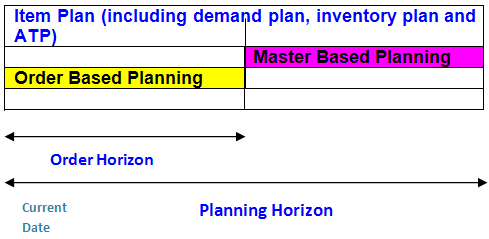Order based Planning and Order Promising
Order based Planning: Order-based planning is the functionality that plans planned orders to cover components and end items. This functionality largely corresponds to Materials Requirement Planning (MRP) and uses BOMs (Bill of Materials) to explode material requirements and the routings to calculate lead-time of planned production orders.
Differences between Master and Order based Planning
- When production is planned in order-based planning, all necessary components and required production capacity is taken into account. This information is retrieved from the item’s BOM and routing, respectively. When production is planned in master-based planning, only those components and production facilities are considered which have been labeled as critical.
- Order-based planning is for short-term supply planning where planning data is recorded on a second by second basis. Master-based planning is used for long-term supply planning, where planning data is recorded on time bucket. Control of this combination of planning methods is done by setting an item’s order horizon.
- Planned supply order is generated in order based planning where as supply plan for the period of planning horizon is created by master based planning.
A combined overview of order based planning and master based planning

If order horizon is set to zero, the system plans supply through master based planning only. If order horizon is equal to planning horizon, the system plans all supply through order based planning
Procedure for Order based Planning
- Time phased overview: This functionality is used to get a time-phased overview of order planning, which lists overview values for demand and forecasted consumption on the one hand, and scheduled receipts and planned supply on the other hand. It is possible to simulate the above values under various scenarios to see resultant projected inventory.
- Rolling and updating of actual scenario: A rolling plan is a scenario of which the planning horizon and plan period division is regularly shifted in time. The goods flow transactions are updated here for all components of the plan items.
- Order Simulation: This functionality is used to carry out an order-based-planning run to generate orders of the following order types. Planned supply orders are created within planned items order horizon for both main and component level items if the top down option is selected. In case of adoption of bottom up option, the item selection is extended to parent items.
- Planned production order.
- Planned procurement order.
- Planned distribution order.
- Review and analyzing order plan: Orders are reviewed and analyzed particularly in respect of goods flow mismatch between demand and supply, which can be further drilled down to various regions and sales channel. The system provides various graphical tools and planning board for this purpose. After taking corrective measure regarding materials availability and capacity constrain, planned orders are transferred to execution modules.
Order Promising - ATP & CTP: Demand forecasts are gradually consumed by actual customer orders. The calculated item quantity that is available (to sell or consume) on a certain future date, based on the current supply planning is known as Available to promise (ATP). ATP is an indicator of inventory availability that is specifically geared to the process of order acceptance. ATP may be for one period or may be cumulative over a number of periods. When it comes to accepting customer orders, a plan period’s cumulative ATP is a clear indicator of the order quantity that can still be promised to deliver in that plan period.
The functionality behind the notion of cumulative ATP is further enhanced by Enterprise Planning’s extended capable-to-promise (CTP) checking techniques. These techniques not only consider what can be promised on the basis of the planned supply, but also explore the possibility of producing more than what the current supply planning indicates. There are various dimensions of checking CTP such as:
- Capacity CTP - If ATP does not provide sufficient quantity, capacity CTP checks if critic resources needed to produce extra quantity are available.
- Component CTP - If ATP does not provide sufficient quantity, Component CTP checks if critical components needed to produce extra quantity are available.
| ❮❮ Previous | Next ❯❯ |
 Related Articles
Related Articles
- Planning Functionality of an ERP System
- Demand Planning & Master Planning
- Supply Chain & Distribution Planning
- Setting Up Service Module
- ERP Package - Sales Module
Authorship/Referencing - About the Author(s)
The article is Written By “Prachi Juneja” and Reviewed By Management Study Guide Content Team. MSG Content Team comprises experienced Faculty Member, Professionals and Subject Matter Experts. We are a ISO 2001:2015 Certified Education Provider. To Know more, click on About Us. The use of this material is free for learning and education purpose. Please reference authorship of content used, including link(s) to ManagementStudyGuide.com and the content page url.